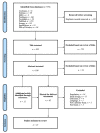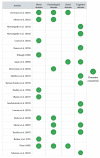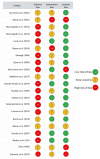Building the Foundation of Aquatic Literacy in 4-6 Years-Old Children: A Systematic Review of Good Pedagogical Practices for Children and Parents
- PMID: 35627720
- PMCID: PMC9141389
- DOI: 10.3390/ijerph19106180
Building the Foundation of Aquatic Literacy in 4-6 Years-Old Children: A Systematic Review of Good Pedagogical Practices for Children and Parents
Abstract
Children between the ages of 4-6 years represent the population most affected by drowning accidents, while their early involvement in physical activity, and more specifically in aquatic activities is a key factor in their future physical life journey. The systematic review's purpose was to identify aspects in the intervention's studies with children and/or their parents that had a significant impact on the Aquatic Literacy (AL) dimensions mentioned as motor, psychological, affective, and cognitive. The PICO method was used to define the research question and PRISMA checklist searched for articles in nine databases: Cochrane, Embase, ERIC, ProQuest, PsychInfo, PubMed, Scopus, SportDiscus, and Web of Science. Eligibility criteria were: (1) English language, (2) primary research, (3) population of 4-6 year old children or their parents, (4) intervention study design, and (5) results related to at least one of the AL domains. The strength of evidence and the risk of bias were assessed. Results showed relatively poor number of studies for such a vulnerable population regarding the drowning risk (n = 8 for parents and n = 14 for children intervention). Studies did not show a consensus on which educational approach was more beneficial than others. Concerning parental education, results were rather homogeneous, especially concerning the theoretical frameworks employed and the relevancy to include parents in swimming programs. The development of pedagogical tools for promotion and evaluation, based on the AL theoretical framework, could help to clarify the question of "how to teach" children to prevent drowning and engage young children in long-term physical activities.
Keywords: can swim; parental supervision; preschoolers; swimming intervention.
Conflict of interest statement
The authors declare no conflict of interest.
Figures
Similar articles
-
Factors that influence parents' and informal caregivers' views and practices regarding routine childhood vaccination: a qualitative evidence synthesis.Cochrane Database Syst Rev. 2021 Oct 27;10(10):CD013265. doi: 10.1002/14651858.CD013265.pub2. Cochrane Database Syst Rev. 2021. PMID: 34706066 Free PMC article.
-
Signs and symptoms to determine if a patient presenting in primary care or hospital outpatient settings has COVID-19.Cochrane Database Syst Rev. 2022 May 20;5(5):CD013665. doi: 10.1002/14651858.CD013665.pub3. Cochrane Database Syst Rev. 2022. PMID: 35593186 Free PMC article.
-
Psychological and/or educational interventions for the prevention of depression in children and adolescents.Cochrane Database Syst Rev. 2004;(1):CD003380. doi: 10.1002/14651858.CD003380.pub2. Cochrane Database Syst Rev. 2004. Update in: Cochrane Database Syst Rev. 2011 Dec 07;(12):CD003380. doi: 10.1002/14651858.CD003380.pub3. PMID: 14974014 Updated.
-
Non-pharmacological interventions for stuttering in children six years and younger.Cochrane Database Syst Rev. 2021 Sep 9;9(9):CD013489. doi: 10.1002/14651858.CD013489.pub2. Cochrane Database Syst Rev. 2021. PMID: 34499348 Free PMC article.
-
Eliciting adverse effects data from participants in clinical trials.Cochrane Database Syst Rev. 2018 Jan 16;1(1):MR000039. doi: 10.1002/14651858.MR000039.pub2. Cochrane Database Syst Rev. 2018. PMID: 29372930 Free PMC article.
Cited by
-
Development and evaluation of a school-based physical literacy intervention for children in Germany: protocol of the PLACE study.Front Sports Act Living. 2023 May 31;5:1155363. doi: 10.3389/fspor.2023.1155363. eCollection 2023. Front Sports Act Living. 2023. PMID: 37325795 Free PMC article. Review.
-
Learning how to swim in 5- to 12-year-old children: a scoping review of evidence-based motor learning methods.Front Sports Act Living. 2025 Feb 12;7:1505301. doi: 10.3389/fspor.2025.1505301. eCollection 2025. Front Sports Act Living. 2025. PMID: 40012856 Free PMC article.
References
-
- Rokita A., Ściślak M., Rejman M. Using adolescent interest in swimming to accomplish utilitarian goals of education. S. Afr. J. Res. Sport Phys. Educ. Recreat. 2017;39:105–120.
-
- Denton H., Aranda K. The wellbeing benefits of sea swimming. Is it time to revisit the sea cure? Qual. Res. Sport Exerc. Health. 2020;12:647–663. doi: 10.1080/2159676X.2019.1649714. - DOI
-
- Cox K.L., Burke V., Beilin L.J., Puddey I.B. A comparison of the effects of swimming and walking on body weight, fat distribution, lipids, glucose, and insulin in older women—The Sedentary Women Exercise Adherence Trial 2. Metabolism. 2010;59:1562–1573. doi: 10.1016/j.metabol.2010.02.001. - DOI - PubMed
Publication types
MeSH terms
LinkOut - more resources
Full Text Sources
Medical




